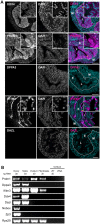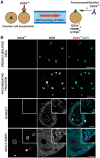FACS-sorted putative oogonial stem cells from the ovary are neither DDX4-positive nor germ cells
- PMID: 27301892
- PMCID: PMC4908409
- DOI: 10.1038/srep27991
FACS-sorted putative oogonial stem cells from the ovary are neither DDX4-positive nor germ cells
Abstract
Whether the adult mammalian ovary contains oogonial stem cells (OSCs) is controversial. They have been isolated by a live-cell sorting method using the germ cell marker DDX4, which has previously been assumed to be cytoplasmic, not surface-bound. Furthermore their stem cell and germ cell characteristics remain disputed. Here we show that although OSC-like cells can be isolated from the ovary using an antibody to DDX4, there is no good in silico modelling to support the existence of a surface-bound DDX4. Furthermore these cells when isolated were not expressing DDX4, and did not initially possess germline identity. Despite these unremarkable beginnings, they acquired some pre-meiotic markers in culture, including DDX4, but critically never expressed oocyte-specific markers, and furthermore were not immortal but died after a few months. Our results suggest that freshly isolated OSCs are not germ stem cells, and are not being isolated by their DDX4 expression. However it may be that culture induces some pre-meiotic markers. In summary the present study offers weight to the dogma that the adult ovary is populated by a fixed number of oocytes and that adult de novo production is a rare or insignificant event.
Figures




Similar articles
-
In vitro differentiation of human oocyte-like cells from oogonial stem cells: single-cell isolation and molecular characterization.Hum Reprod. 2018 Mar 1;33(3):464-473. doi: 10.1093/humrep/dex377. Hum Reprod. 2018. PMID: 29304224
-
Use of DEAD-box polypeptide-4 (Ddx4) gene promoter-driven fluorescent reporter mice to identify mitotically active germ cells in post-natal mouse ovaries.Mol Hum Reprod. 2015 Jan;21(1):58-65. doi: 10.1093/molehr/gau071. Epub 2014 Aug 21. Mol Hum Reprod. 2015. PMID: 25147160 Free PMC article.
-
Production of offspring from a germline stem cell line derived from prepubertal ovaries of germline reporter mice.Mol Hum Reprod. 2016 Jul;22(7):457-64. doi: 10.1093/molehr/gaw030. Epub 2016 May 1. Mol Hum Reprod. 2016. PMID: 27141102
-
Ddx4+ Oogonial Stem Cells in Postmenopausal Women's Ovaries: A Controversial, Undefined Role.Cells. 2019 Jun 28;8(7):650. doi: 10.3390/cells8070650. Cells. 2019. PMID: 31261822 Free PMC article. Review.
-
The existence and potential of germline stem cells in the adult mammalian ovary.Climacteric. 2019 Feb;22(1):22-26. doi: 10.1080/13697137.2018.1543264. Epub 2019 Jan 2. Climacteric. 2019. PMID: 30601039 Free PMC article. Review.
Cited by
-
VASA protein and gene expression analysis of human non-obstructive azoospermia and normal by immunohistochemistry, immunocytochemistry, and bioinformatics analysis.Sci Rep. 2022 Oct 14;12(1):17259. doi: 10.1038/s41598-022-22137-9. Sci Rep. 2022. PMID: 36241908 Free PMC article.
-
Single-cell analysis of human ovarian cortex identifies distinct cell populations but no oogonial stem cells.Nat Commun. 2020 Mar 2;11(1):1147. doi: 10.1038/s41467-020-14936-3. Nat Commun. 2020. PMID: 32123174 Free PMC article.
-
Applying Single-Cell Analysis to Gonadogenesis and DSDs (Disorders/Differences of Sex Development).Int J Mol Sci. 2020 Sep 10;21(18):6614. doi: 10.3390/ijms21186614. Int J Mol Sci. 2020. PMID: 32927658 Free PMC article. Review.
-
Extracellular Localisation of the C-Terminus of DDX4 Confirmed by Immunocytochemistry and Fluorescence-Activated Cell Sorting.Cells. 2019 Jun 12;8(6):578. doi: 10.3390/cells8060578. Cells. 2019. PMID: 31212843 Free PMC article.
-
Isolation of Female Germline Stem Cells from Mouse and Human Ovaries by Differential Adhesion.Int J Cell Biol. 2022 Sep 7;2022:5224659. doi: 10.1155/2022/5224659. eCollection 2022. Int J Cell Biol. 2022. PMID: 36120418 Free PMC article.
References
-
- Zuckerman S. The number of oocytes in the mature ovary. Recent Prog. Horm. Res. 6, 63–108 (1951).
-
- Morgan S., Anderson R. A., Gourley C., Wallace W. H. & Spears N. How do chemotherapeutic agents damage the ovary? Hum. Reprod. Update 18, 525–535 (2012). - PubMed
-
- Johnson J., Canning J., Kaneko T., Pru J. K. & Tilly J. L. Germline stem cells and follicular renewal in the postnatal mammalian ovary. Nature 428, 145–150 (2004). - PubMed
-
- Telfer E. E. et al. On regenerating the ovary and generating controversy. Cell 122, 821–822 (2005). - PubMed
Publication types
MeSH terms
Substances
LinkOut - more resources
Full Text Sources
Other Literature Sources

